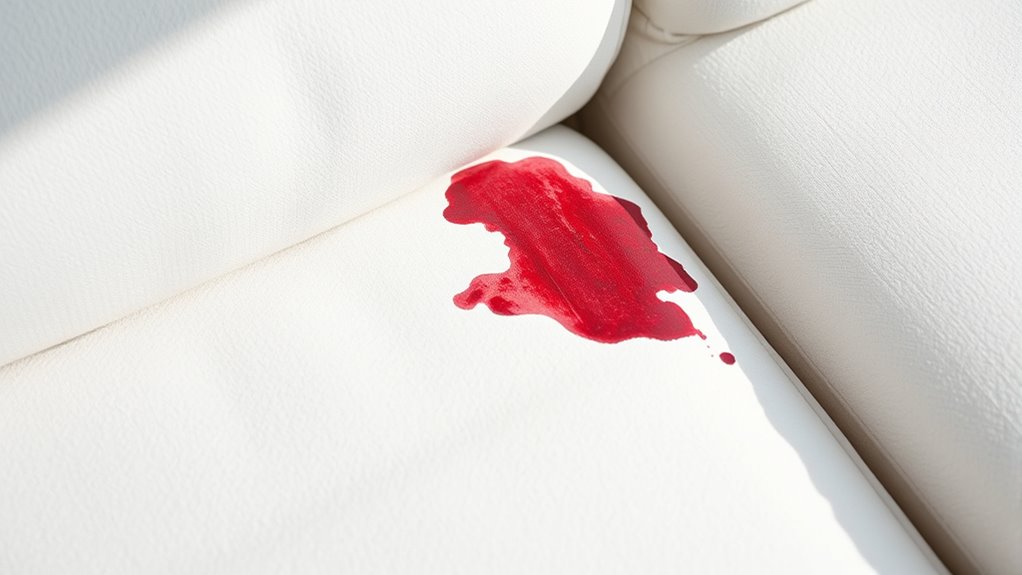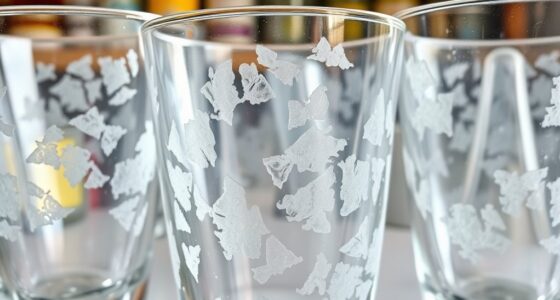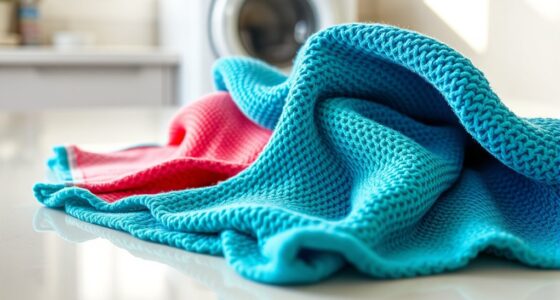If red wine spills on your white sofa, act immediately by blotting the stain with a clean cloth to soak up as much liquid as possible, avoiding rubbing. Sprinkle salt or baking soda over the area to absorb more moisture. Then, prepare a gentle cleaning mixture of water, dish soap, and vinegar, testing it on a hidden spot first. Carefully treat the stain, rinse with cool water, and blot dry. For more detailed steps, keep exploring to save your sofa.
Key Takeaways
- Act quickly to blot excess wine with a clean cloth, avoiding rubbing to prevent deeper stain penetration.
- Immediately sprinkle salt or baking soda to absorb moisture and create a barrier against the stain.
- Prepare a gentle cleaning solution with water, dish soap, and vinegar; test on a hidden area before use.
- Carefully apply the cleaning solution to the stain, working from outside inward, then rinse with cool water and blot dry.
- Allow the sofa to air dry, monitor for residual stains, and avoid harsh chemicals to preserve fabric integrity.
Act Quickly to Prevent the Stain From Setting

When you spill red wine on your white sofa, acting quickly can make all the difference. The first step is to identify if your fabric is colorfast; if it is, you have a better chance at successful DIY stain removal. Time is critical because the longer the stain sits, the more likely it is to set. Blot the spill immediately with a clean, absorbent cloth to lift as much liquid as possible. Avoid rubbing, which can push the stain deeper. If your fabric is colorfast, you can start applying a homemade cleaning solution right away. Quick action prevents the wine from soaking in further, giving you a better shot at removing the stain before it becomes permanent. Remember, speed is your best ally.
Blot the Excess Wine Gently With a Clean Cloth
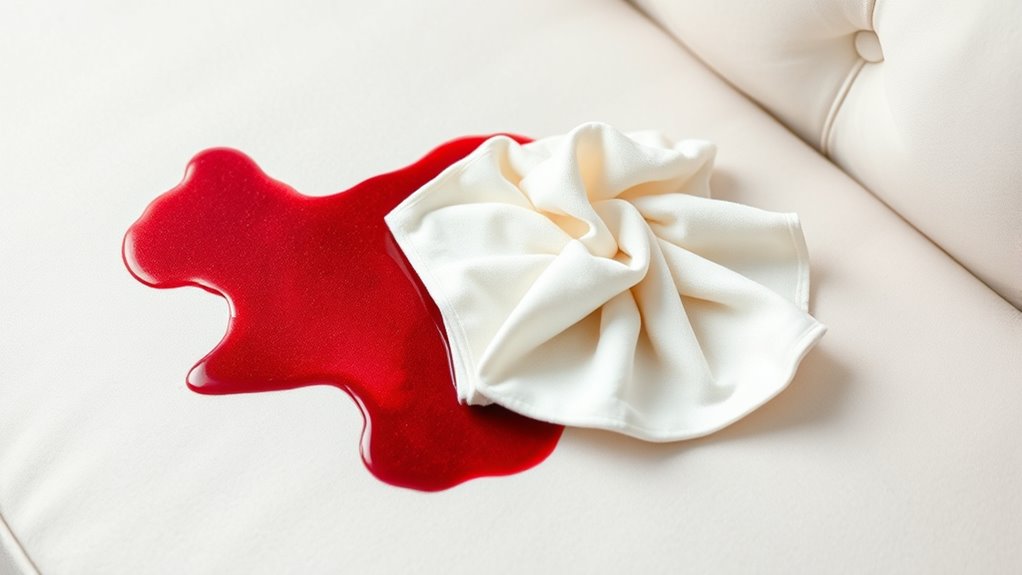
Gently blot the spill with a light cloth to lift the excess wine without spreading it further. Press softly, and avoid rubbing, which can push the stain deeper into the fabric. Using a clean cloth guarantees you don’t transfer dirt or additional liquid onto the sofa. Being mindful of family photoshoot fails, humorous mishaps can happen, but quick action can minimize lasting damage.
Use a Light Cloth
To prevent the stain from spreading, start by using a light cloth to remove excess wine. Gently blot the area, avoiding any rubbing that could push the stain deeper into the fabric. When choosing your cloth, consider the fabric types of your sofa—delicate textiles require extra care. A clean, soft microfiber or cotton cloth works well for most materials, aligning with good dining etiquette by handling spills carefully. Use a light pressing motion rather than heavy scrubbing. This ensures you lift the liquid without damaging the fibers. Remember, the goal is to absorb as much wine as possible without spreading it further. Additionally, using a flat iron bike can be an effective way to check your equipment’s performance, ensuring you have the right tools for any situation. Taking your time at this stage helps set the foundation for more effective stain removal later.
Pat, Don’t Rub
Instead of rubbing the stain, focus on patting it with a clean cloth to lift the excess wine. Remember, pat, don’t rub. Rubbing can push the stain deeper into the fabric, making it harder to remove. Gently pressing helps absorb the liquid without spreading it further. Use a fresh cloth each time you pat to avoid reapplying the wine. Here’s a quick guide:
| Action | Technique | Result |
|---|---|---|
| Pat | Light, gentle pressure | Absorbs excess liquid |
| Don’t rub | Avoid scrubbing | Prevents spreading stain |
| Use clean cloth | Switch cloth frequently | Keeps stain from spreading |
Patting ensures you lift the wine without damaging your sofa’s fabric, making cleanup more effective.
Apply a Salt or Baking Soda Barrier to Absorb the Spill
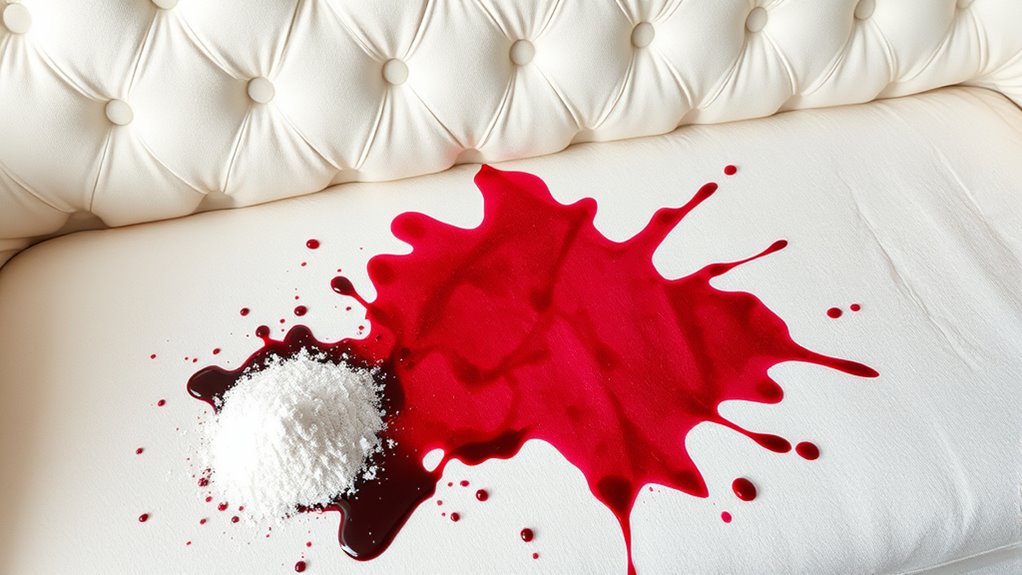
As soon as the spill happens, sprinkle salt directly onto the red wine to help draw out the moisture. Alternatively, you can create a baking soda layer over the stain, which works to absorb the liquid quickly. Acting promptly with these barriers can make a big difference in preventing the stain from setting. Additionally, digital literacy can be a valuable skill in managing household emergencies efficiently.
Immediate Salt Application
Applying salt or baking soda immediately after the spill can help prevent the stain from setting deeper into your sofa fabric. The key is quick action, especially since different fabric textures absorb liquids differently. By sprinkling salt or baking soda right away, you create a barrier that absorbs excess wine and limits its penetration. This early step enhances stain prevention, giving you a better chance to remove the spill completely. Make sure to cover the entire affected area generously, but avoid rubbing, which can push the liquid further in. The faster you respond with this barrier, the more effective it will be at preventing a lasting stain. Remember, prompt salt application is a simple yet powerful first move in your emergency stain plan. Absorption efficiency plays a crucial role in how well the barrier prevents deep-set stains.
Baking Soda Layer
To create an effective barrier against the wine spill, sprinkle a generous layer of baking soda or salt directly onto the affected area immediately after the spill occurs. This layer helps absorb the liquid quickly, preventing it from seeping deeper into the fabric texture. By applying a barrier promptly, you reduce the stain’s longevity and limit its spread. Be sure to cover the entire spill area evenly for maximum effectiveness. The baking soda or salt acts as a sponge, drawing out moisture before it sets into the fibers. This simple step is essential in the initial emergency response, especially on delicate or plush fabrics, where stains tend to embed more stubbornly. Acting fast with a baking soda layer can make all the difference in preserving your sofa’s pristine appearance. Additionally, understanding angel numbers can provide comforting guidance during stressful situations like stain accidents.
Prepare a Gentle Cleaning Solution for the Stain
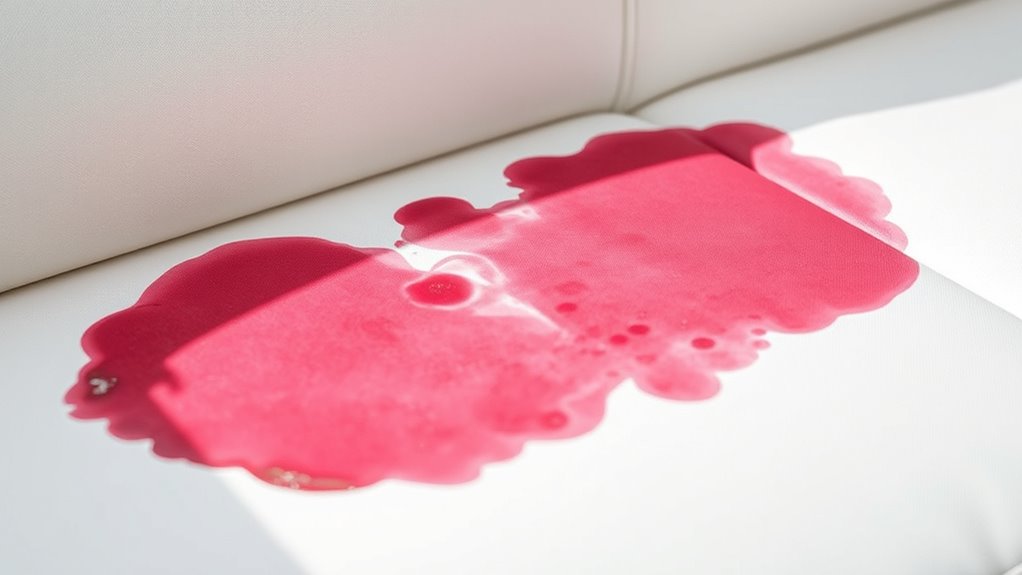
When preparing a gentle cleaning solution for the red wine stain on your white sofa, it’s important to choose ingredients that won’t damage the fabric. Using mild, natural substances helps with gentle cleaning and stain prevention, avoiding harsh chemicals that could worsen the damage. Picture yourself gathering simple, safe items to tackle the stain effectively.
Gather safe, natural ingredients for gentle stain removal on your white sofa.
You can also consider using appropriate cleaning techniques to ensure the stain is lifted without harming the upholstery.
- A small bowl of cool water
- A few drops of mild dish soap
- White vinegar
- A clean, soft cloth
Mix these ingredients to create a gentle cleaning solution that lifts the stain without harming the fabric. This approach ensures you treat the spill delicately, reducing the risk of spreading or setting the stain further. Always prioritize stain prevention by acting quickly and using gentle, proven solutions.
Test the Cleaning Solution on a Hidden Area First
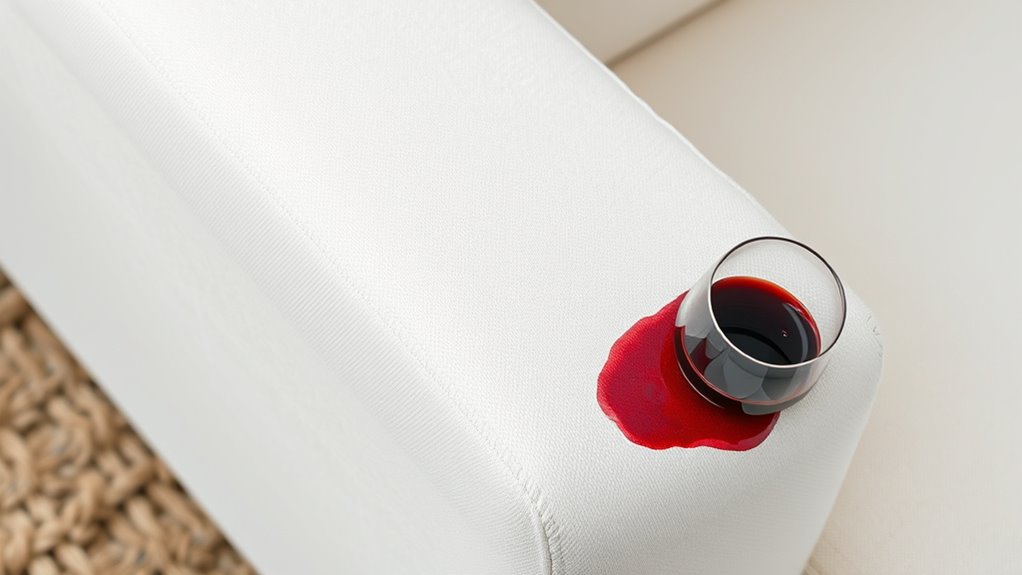
Before treating the visible stain, it is crucial to test your cleaning solution on a small, inconspicuous area of the sofa. This step ensures your fabric testing is safe and prevents further damage. Choose a hidden area, like the underside or back of the sofa, to avoid obvious discoloration. Apply a small amount of the solution and wait a few minutes to observe any changes in color or texture. If the fabric remains unaffected, you can proceed confidently with cleaning the stain. If discoloration or damage occurs, try a different solution or consult a professional. This careful fabric testing on a hidden area helps protect your sofa and ensures you don’t unintentionally worsen the stain or cause lasting harm. Additionally, understanding the environmental considerations of your cleaning products can help you choose eco-friendly options that won’t harm your home or the planet.
Carefully Treat the Affected Area With the Solution
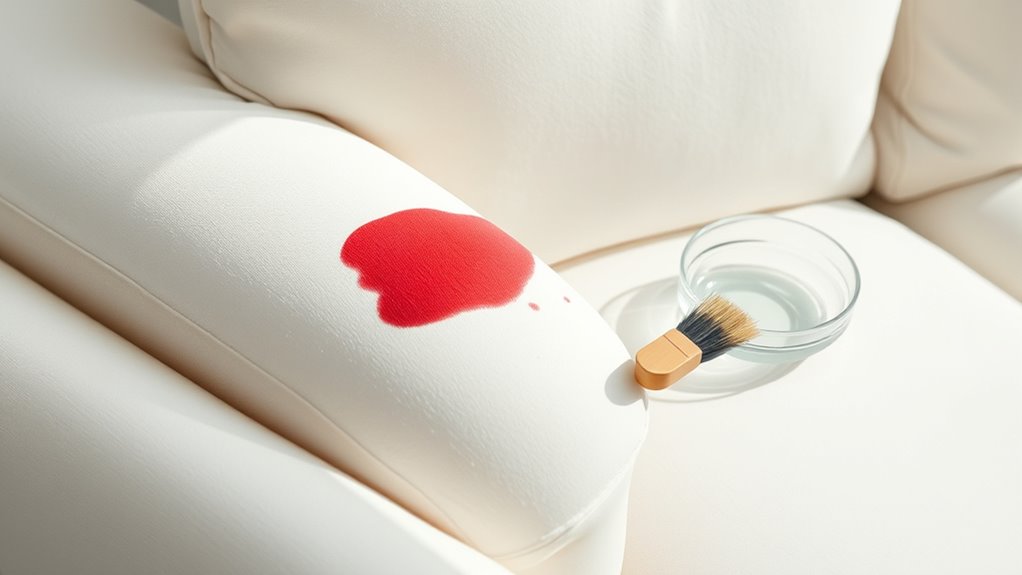
Once you’ve confirmed that the cleaning solution is safe for your fabric, carefully apply it directly to the stained area. Use a clean cloth or sponge to gently dab, avoiding rubbing that could spread or deepen the stain. This targeted approach guarantees effective stain removal while protecting your fabric. Imagine the solution seeping into fibers, loosening the wine’s pigment. Visualize the fabric absorbing the liquid, lifting the stain gradually. Focus on gentle, deliberate movements to prevent damage and maintain fabric care. Keep in mind these steps:
- Apply the solution in small, controlled amounts
- Use a blotting motion rather than scrubbing
- Work from the outside of the stain inward
- Avoid oversaturating the material
This method maximizes stain removal and preserves your sofa’s integrity.
Rinse and Blot to Remove Residue and Excess Moisture
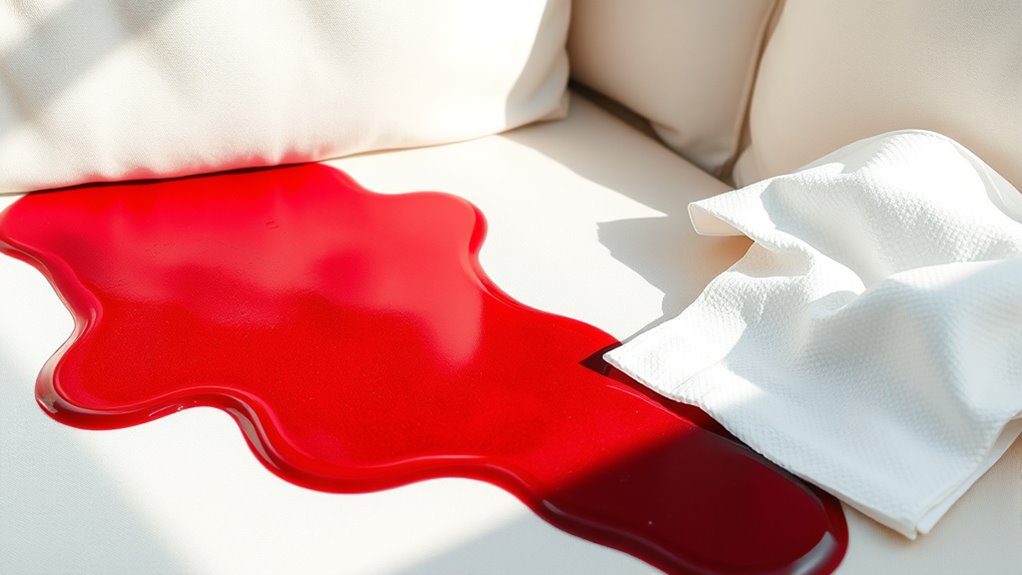
After applying the cleaning solution, it’s important to rinse the area with clean, cool water to remove any remaining residue. Use a gentle stream to avoid disturbing the fabric texture, which can vary from smooth to coarse. Rinsing helps lift out the stain color, preventing it from setting deeper into the fibers. Once rinsed, gently blot the area with a clean, absorbent cloth or paper towel to remove excess moisture. Be careful not to rub, as this can spread the stain or damage the fabric. Focus on lifting both the stain color and any residual cleaner, ensuring the fabric stays as undisturbed as possible. This step helps prepare the sofa for drying while minimizing the risk of lingering stains or damage to its texture. Additionally, understanding fabric types can help you choose the safest cleaning methods for your sofa.
Allow the Sofa to Air Dry and Monitor for Remaining Stains
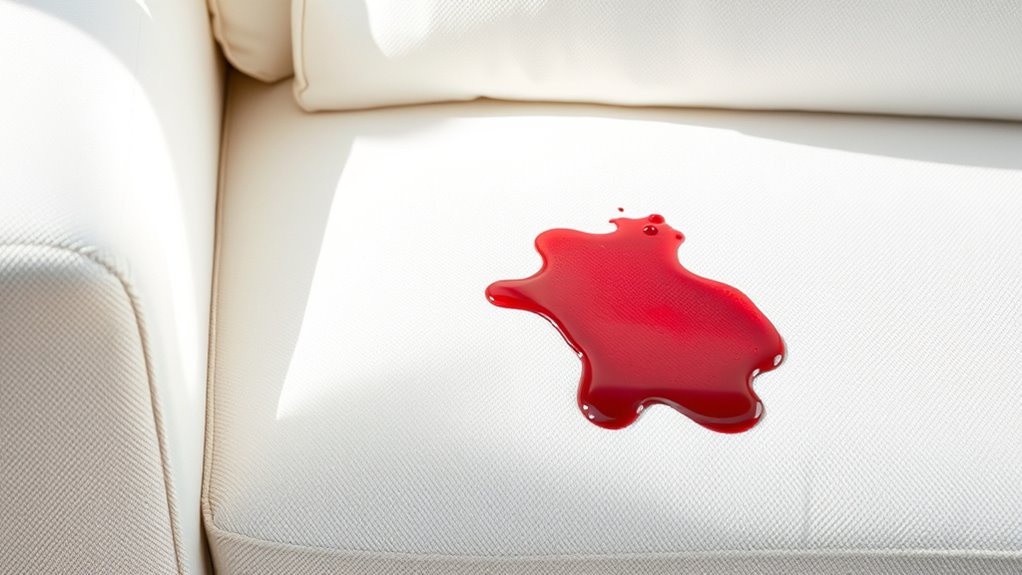
Allow the sofa to air dry naturally, which helps prevent new stains from setting and preserves the fabric’s integrity. During this time, keep a close eye on the area, practicing stain monitoring to catch any remaining spots early. As the fabric dries, you might notice watermarks or faint traces of the wine that need further attention. Additionally, embracing small daily choices that promote well-being can help you stay calm and patient during the stain removal process.
Frequently Asked Questions
Can Commercial Stain Removers Be Used on Delicate White Upholstery?
You can use commercial stain removers on delicate white upholstery, but you need to verify fabric safety and chemical compatibility first. Always read the product label carefully to guarantee it’s safe for delicate fabrics. Test the remover on a small, hidden area to avoid damage or discoloration. Using a gentle, upholstery-specific stain remover helps protect your fabric while effectively removing stains, preventing potential harm to your delicate white sofa.
How Long Should I Wait Before Applying Cleaning Solutions After the Spill?
Think of the stain as a ticking clock, and the timing of cleaning as your secret weapon. You should act within 5 to 10 minutes of the spill, applying cleaning solutions promptly to prevent stain setting. Waiting too long allows the wine to embed deeper into the fabric, making removal harder. So, don’t delay—your quick action saves your white sofa from a lasting mark.
Are There Natural Alternatives to Salt or Baking Soda for Stain Prevention?
You can try natural remedies like crushed lemon or lime slices, which act as natural stain preventers for your white sofa. Coconut oil mixed with baking soda creates an effective alternative prevention method against stains. These natural remedies are eco-friendly and safe for most fabrics, providing an alternative prevention strategy that helps keep your sofa spotless. Just remember to test any solution on a small, hidden area first to avoid damage.
Will Vinegar Damage the Fabric of My White Sofa?
Vinegar safety depends on your sofa’s fabric compatibility. If you have a delicate or untreated fabric, vinegar could cause damage or discoloration. To stay safe, test a small, hidden area first. Generally, vinegar is safe for many fabrics and can help with stain removal, but always check your sofa’s care label. If unsure, consult your manufacturer or opt for a gentler stain remover to avoid any damage.
How Can I Prevent Future Red Wine Stains on My White Furniture?
Imagine red wine turning your pristine white sofa into a masterpiece of chaos! To prevent this disaster, you gotta invest in fabric protection like waterproof sprays and use spill prevention tactics. Keep drinks away from the edges, use coasters, and always have a towel handy. Regularly treat your sofa with stain-resistant products, and you’ll dramatically reduce the risk of future red wine stains—your furniture’s best armor!
Conclusion
If you act fast, you can save your white sofa from red wine stains. Imagine spilling wine during a dinner party—quickly blotting and applying salt can prevent a lasting mark. With patience and the right approach, your sofa can look as good as new. Don’t let a small accident turn into a permanent stain—stay calm, follow these steps, and your furniture will thank you for it.
